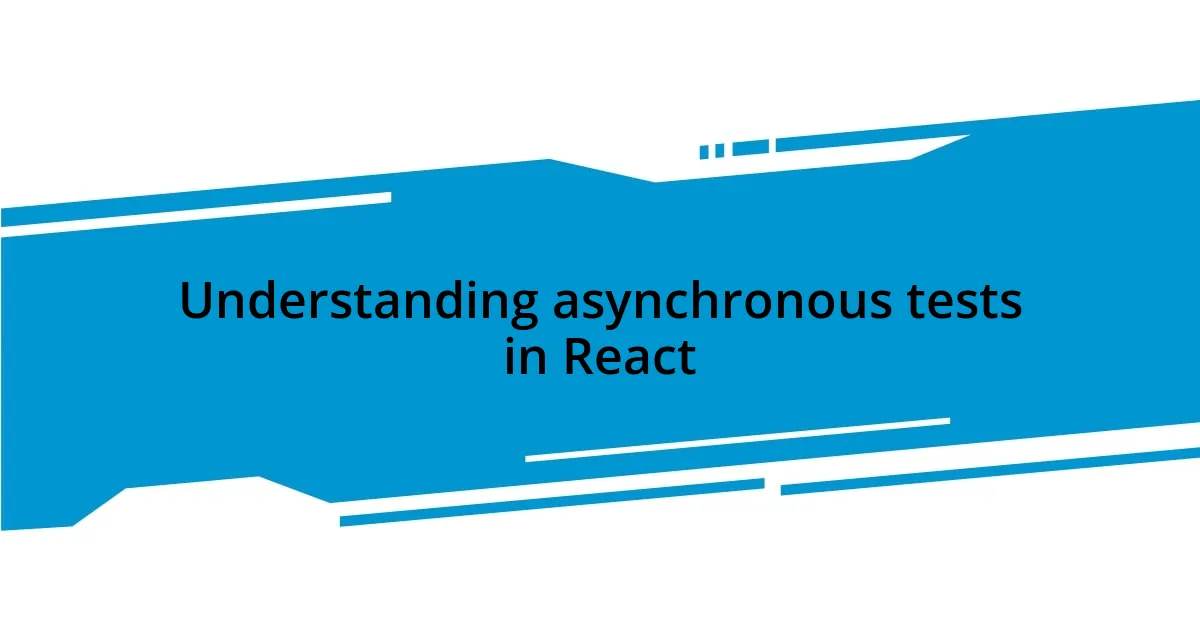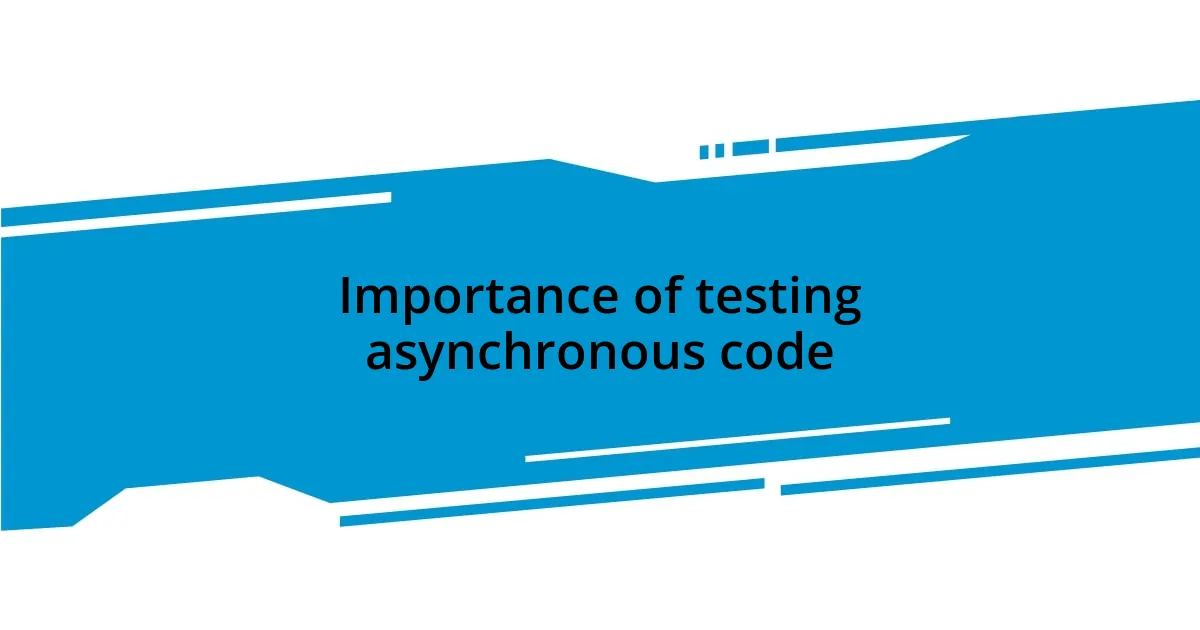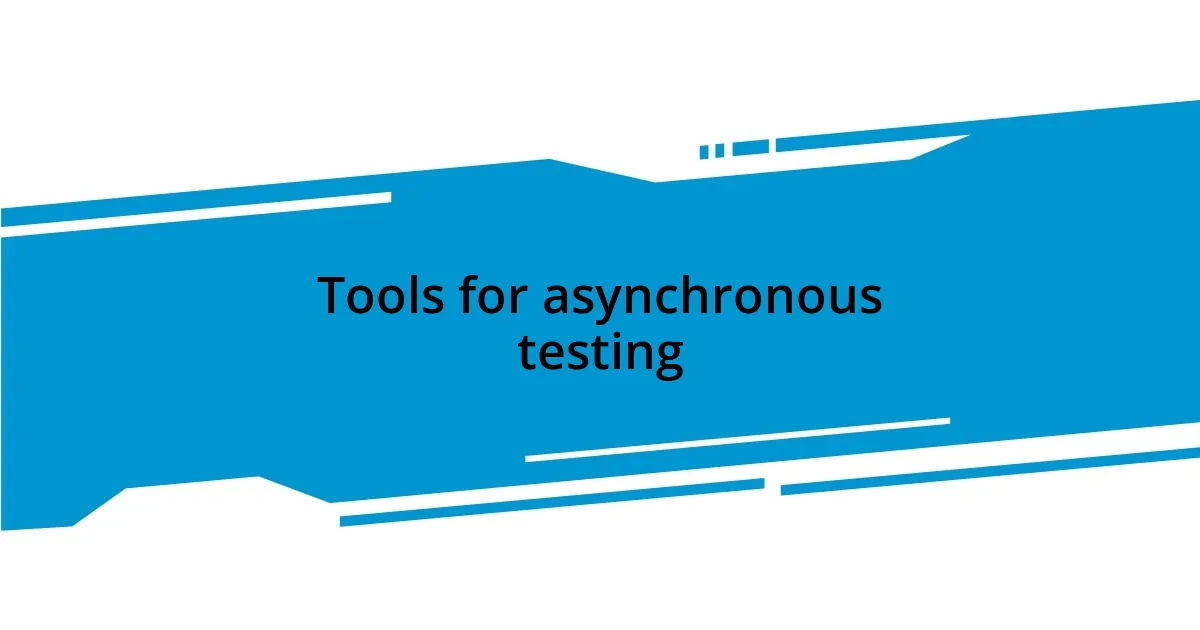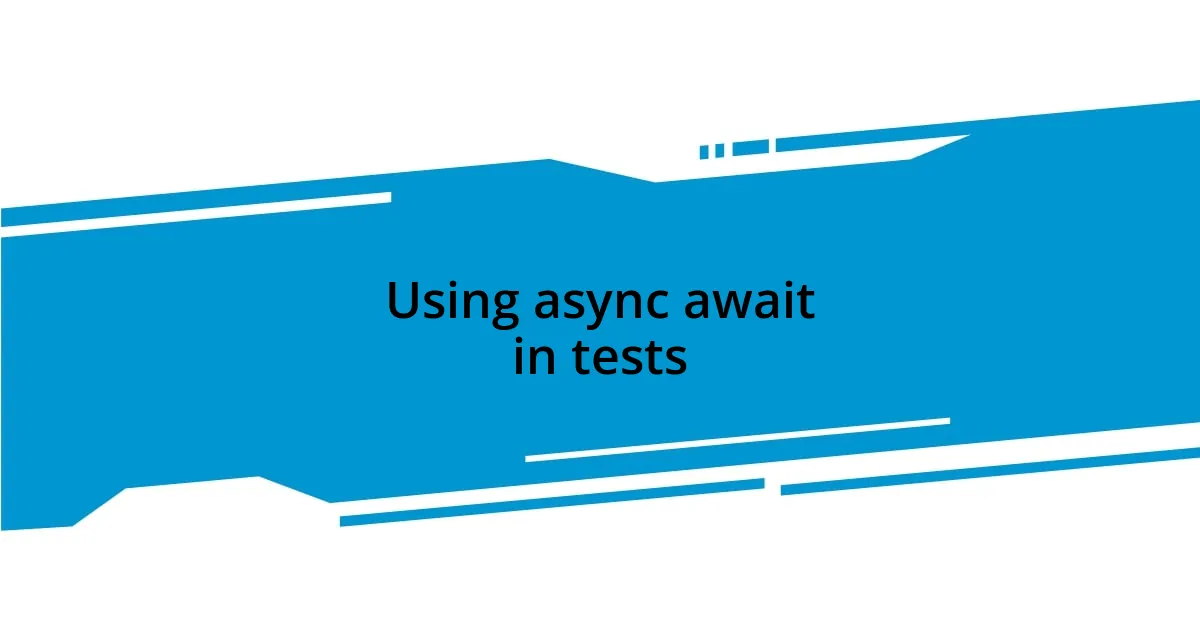Key takeaways:
- Understanding async/await vs. promises is crucial for effective asynchronous testing in React.
- Testing asynchronous code enhances user experience, error handling, and debugging efficiency.
- Choosing the right tools (like Jest and React Testing Library) is important for smooth testing workflows.
- Writing clear, isolated tests and effectively handling promises improves reliability and maintainability of your tests.

Understanding asynchronous tests in React
Asynchronous tests in React can seem daunting at first, especially when you’re used to working with synchronous code. When I first encountered asynchronous testing, I felt overwhelmed. However, I quickly learned that understanding the flow of data and how components render asynchronously is crucial. Doesn’t it feel like a little magic when a component updates seamlessly without blocking the user experience?
The heart of asynchronous testing lies in the way we handle promises and async/await syntax. I remember struggling with a test that relied on data fetching; it felt like I was chasing shadows. But once I grasped that using waitFor and findBy methods could let me wait for elements to appear, everything clicked. Wouldn’t you agree that it’s rewarding when your tests not only pass but also reflect real user interactions?
Another aspect I find fascinating is how testing libraries like React Testing Library simplify the process. They encourage writing tests that reflect user behavior rather than implementation details. I still recall the moment I shifted my perspective from technicalities to focusing on usability; suddenly, the tests became not just about checking code but ensuring a great experience for users. Isn’t that what we’re all aiming for in the end?

Importance of testing asynchronous code
Testing asynchronous code is fundamental to ensuring that applications behave predictably. I remember running into a situation where a minor delay in data fetching caused major UI glitches. It struck me how crucial it was to assert not only whether the data was fetched but also how the UI adjusted after the fact. It’s essential to understand that our users experience these delays, and if we don’t account for them in tests, we might overlook critical failures that affect their experience.
Here are a few reasons why testing asynchronous code is vital:
- User Experience: It mirrors real-world scenarios where loading times and data fetching impact how users interact with the application.
- Error Handling: Tests allow us to validate how our code gracefully handles failed network requests, which is crucial for maintaining user trust.
- Debugging Efficiency: By catching potential issues early in the testing phase, we save time and resources in the long run when discrepancies occur in production.

Tools for asynchronous testing
As I delved deeper into asynchronous testing, I found that choosing the right tools significantly influences the experience. Tools like Jest and React Testing Library stand out for their seamless integration with React. In particular, Jest provides functions for mocking and spies, which make it easier to handle asynchronous operations. When I first set up tests with these tools, the initial setup felt overwhelming, but soon, I realized their power in streamlining the testing process. Have you ever faced a complex async workflow and wished for a bit more magical help? These tools are like that helping hand.
When comparing various tools for asynchronous testing, I learned that the choice largely depends on your specific project needs and team expertise. For instance, Cypress offers an interactive testing experience with a user-friendly interface that allows real-time debugging. On the other hand, while Enzyme is great for unit testing, it struggles with async code. I remember my first attempt with Cypress, where I could literally see the tests running in real time; it felt liberating to catch bugs instantly. It truly enhanced my confidence in testing different scenarios.
Here’s a simple comparison of these tools:
| Tool | Strengths | Weaknesses |
|---|---|---|
| Jest | Fast, great mocking capabilities, easy to use with React. | Setup can be complex for beginners. |
| React Testing Library | Encourages testing user interactions, minimal configuration. | Limited in handling deep component trees. |
| Cypress | Real-time testing, visual feedback, easy debugging. | Slower for unit tests, primarily E2E testing. |
| Enzyme | Powerful for shallow rendering and unit testing. | Poor handling of async code, leads to potential flakiness. |

Best practices for writing tests
When crafting tests, clarity is key. I’ve found that writing descriptive and meaningful test names helps both me and my team understand the purpose of each test at a glance. For instance, instead of a generic label like testFetchData, adopting a more descriptive approach, such as should render loading state when data is being fetched, instantly conveys the intent. This not only enhances readability but also aids in maintaining and updating tests over time.
Another best practice is to keep tests isolated. I vividly remember a time when I overlooked this principle, leading to a cascade of failures that took hours to untangle. It’s a common pitfall to include multiple assertions in a single test. By focusing on one behavior per test, I can pinpoint exactly where things go wrong. Think about it: how frustrating is it to chase a bug through an endless web of mixed responsibilities?
Lastly, I can’t stress enough the importance of running tests frequently. Integrating testing into your continuous integration pipeline ensured that my code remained robust throughout development. I’ve freshly learned that the more frequently I run my tests, the more confident I feel about pushing new features. It’s like having that safety net below me; it allows for greater creativity and innovation in my coding. How reassuring is it to know I can refactor or enhance functionality without fear?

Handling promises in tests
Handling promises in tests can be a bit tricky, but I’ve learned a few effective strategies over time. When I started using Jest, I quickly found myself needing to test promise-based functions. One thing that really helped was using async/await syntax, as it makes my tests read more like synchronous code. Have you tried it? It felt like a revelation when I first refactored my tests. Instantly, my tests became clearer and easier to follow.
Another tip I’d offer is to always return the promises from your test functions. Initially, I was tempted just to use .then() and leave it at that, but I realized that returning the promise ensures Jest knows when my test has completed. It was a game-changer for me, as I no longer struggled with timing issues that caused my tests to fail unpredictably. Isn’t it frustrating when you feel like you’ve nailed a scenario, only to have a fluke failure?
Mocking promises is also critical for handling promises effectively in tests. I remember the first time I started mocking API calls in my tests. Using tools like jest.mock() gave me control over the promise resolution. It’s such a relief to simulate different responses—like errors or timeouts—without making actual network requests. It saved me so much time and made my tests far more reliable. Have you considered mocking in your tests? Trust me, it’s worth it!

Using async await in tests
Using async/await in tests has completely transformed my testing experience. I remember one particular instance where I was testing a component that fetched data from an API. The shift to async/await made it feel like I was talking to my code in plain English, rather than wrestling with convoluted promise chains. Isn’t it nice when the syntax feels natural and intuitive?
Incorporating async/await can seem daunting at first, but the clarity it brings is undeniably rewarding. Just last week, I had a friend struggling with convoluted tests that relied heavily on callbacks. When I suggested refactoring them with async/await, he was amazed at how much easier his tests became to read and maintain. I found it satisfying to see someone else experience the same “aha” moment that I felt when I first adopted this approach.
It’s essential—I’ve learned—to not forget error handling when using async/await. I recall a test that intermittently failed because I neglected to handle a rejection properly. By wrapping my await calls in try/catch blocks, I managed to catch those sneaky errors right away. Reflecting on those moments, it’s incredible how a few lines of code can enhance both the reliability of my tests and my confidence in the codebase. Have you had a similar experience where a minor adjustment made a world of difference?

Debugging failed asynchronous tests
When it comes to debugging failed asynchronous tests, I often find myself retracing my steps to identify precisely where things went awry. I remember grappling with a particularly tricky test failure stemming from an API request that was either slow or nonexistent. It was a head-scratcher until I realized that the mock I had set up was incorrectly configured. Do you ever feel those moments of clarity after a frustrating search? It’s like a light bulb illuminating what seemed like an impenetrable fog.
I also recommend checking the error messages closely. Early on in my testing journey, I would overlook these because they seemed cryptic and unhelpful. But then I discovered that digging into the stack trace often revealed the root cause of the failure. One time, an asynchronous call that returned an error left me puzzled—until I noticed the stack trace pointed to a function where I had omitted a crucial parameter. That’s the moment I learned that some debugging moments require patience and keen observation. Have you had an eye-opening experience with error messages?
Lastly, employing console.log() effectively plays a crucial role in my debugging process. I vividly recall a time when I placed logs at various points in the promise chain to capture the response behavior in real-time. It helped me visualize the flow of data and pinpoint exactly where things diverged from the expected outcome. I was relieved and a bit amused when I realized I’d missed an await keyword, causing the test to break unexpectedly. It’s funny how such a small detail can turn debugging into an extensive hunt. Have you found your own debugging hacks that you swear by?













